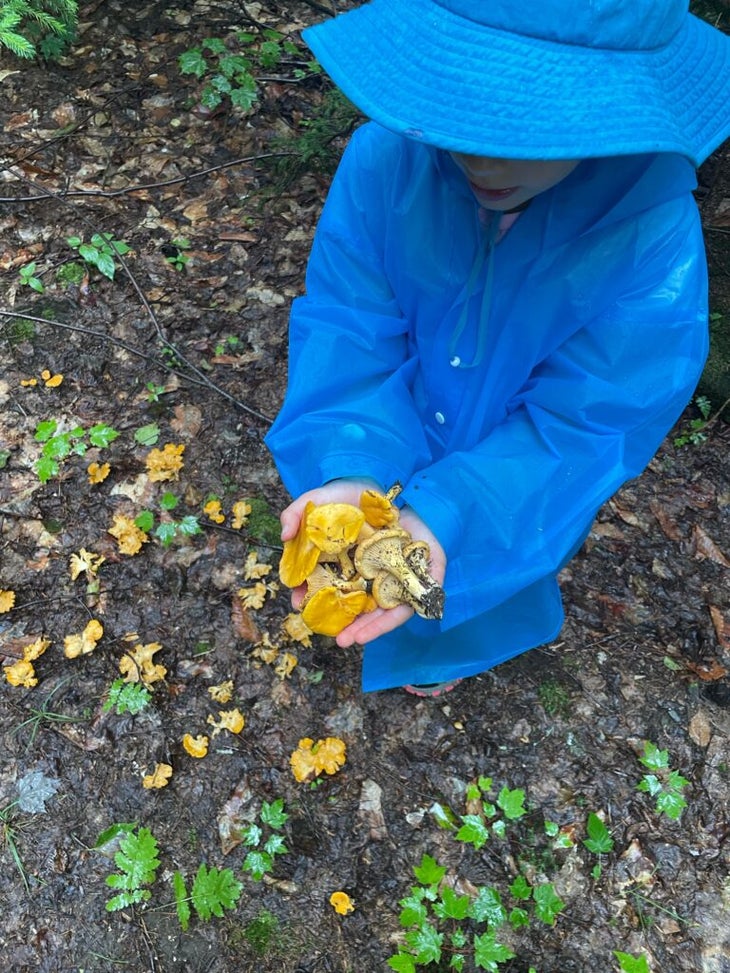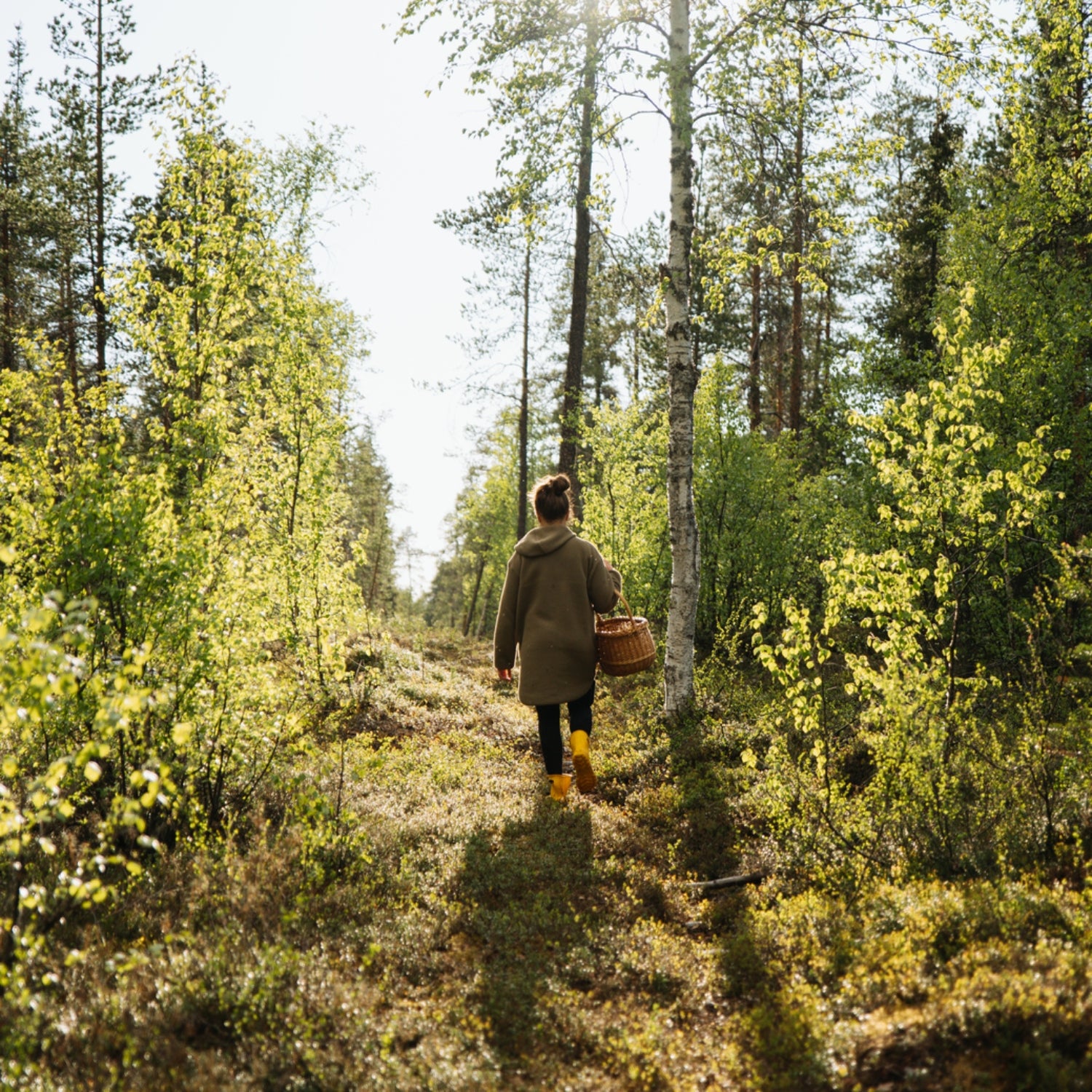It wasn’t crossing over into my forties that felt so unsettling, it was the physical signs—subtle as they were—that made aging bloom into something real and looming.
After my fortieth birthday, over the course of two years, my periods became heavier and more painful. Now, at 42, I sometimes spot between cycles. Sometimes my period comes early. Every month, days before I begin to bleed, my left breast becomes tender in one spot like the knotted growth of a burl budding from the trunk of a tree. When I asked the doctor if all of these things could be due to hormonal shifts that come with perimenopause, she shook her head. “Forty-two? You’re too young for that.” But I wasn’t convinced. I feel my seasons changing, gray hairs streaking across my head and eyebrows like leaves surrendering to their fall colors.
This uneasiness around aging and my body changing settled within me, a low rumbling that I tried to ignore. I have two young kids to distract me, but the shifts whispered premonitions of what the near future brought—increasing signs of perimenopause, menopause, more folds of skin around my shoulder blades, more lines across my forehead and around my eyes like new grooves in the ground after heavy rains.
Both my husband and I were becoming increasingly aware of the passage of time. So when we saw the listing for a 1786 farmhouse in dire condition in Bridgewater, Vermont—a two and a half hour drive from our Boston home—we took a leap of faith. It wasn’t only the old house and its potential that made me fall in love. It was the land. The more I read about the natural world and edible plants, like wild raspberries and ramps, that surely thrived there, the more eager I became to get out into the wilderness and explore.
We closed on the house in December 2022, with plans to rehabilitate it over the next few years so that we could make an official move. At the first evidence of snow melt and new green, I set out on my mission. In the woods, my body seemingly betraying me with its own autumn during Vermont’s spring, I was eager to see what the land could offer. It was my first year of foraging. I came prepared, and maybe a bit overconfident. I had read the books, I had watched the YouTube videos. In unusual optimism, I bought a mesh bag and slung it over my shoulder to carry my bounty. In my coat pocket, a pocket knife was ready to assist in any find.
It was here in the Vermont wilderness, away from my role of mother, housewife, ringleader—whatever you want to call it—that I tried to find myself again. I walked the woods, searching for wild treasures in order to stop myself from imagining I could walk backwards over the divide of 40. I knew that I had to stop focusing on what was behind me—my younger self—or I’d forget where I belonged, both in time and in my body.

And so, I turned my attention to what I could find in the newness of spring—specifically, ramps, that wild allium with a pungent onion and garlic flavor. Every few minutes I stopped, listened to the sounds of water dripping from bare branches, and scanned the land around me for anything green coming up from the ground. Every now and then my heart skipped at the sight of something that could be the new delicate growth of an Allium tricoccum. Falling to my knees, not caring whether my pants got brown and wet, I ripped a leaf and sniffed, desperate to smell onion and garlic. Each time I got excited, I found that I was putting all my hopes into lily-of-the-valley. Hours passed, days passed, my legs burned from the hills I climbed. Still, no ramps. There were only lookalikes, those lily-of-the-valley and then the abundant false hellebore that sat deceivingly beside streams.
Here I was, 42, cheeks red from the still-cold air, frustrated now with both my body and the land.
I’d like to say that days after my sense of defeat I found a patch of ramps, foraged them sustainably, brought them home, and cooked them for my husband and kids. But I never found the ramps. Instead, days later, I came across a large patch of fiddleheads. It wasn’t what I originally set out for, but I couldn’t help but grin as I cut them at their base and stuffed them into my pockets. Back home, I fried them in butter and salt and let my kids crunch curiously. Summer was fast approaching, and I began to research what I could find next.
Summer was full of its own surprises. The small three-leaved plants that I’d always thought were clovers turned out to be the heart-shaped wood sorrel that gifted us a tingle of lemon flavor. The hill that our farmhouse sits on bloomed with small, tart wild strawberries. My daughter and I found a large patch of chanterelles along a trail in the nearby woods. A surprise sprinkling of hedgehog mushrooms taught me that they are one of the better-tasting edible fungi. I enjoyed these finds, but carried with me the dread of autumn and winter. This, I believed, was when the bounty would diminish and I would need to prepare myself for the wait for spring. I expected the wilderness to act as our bodies do—spring and summer (youth) would provide, late autumn and winter (middle age and beyond) would deplete.
Soon I could feel the shift in the air and the plants around me. Again, the seasons changed, and I prepared for disappointment, waiting for the woods to offer only silence and snow in the late autumn freeze. On a farewell walk in the woods, the first flakes dusting the dirt and patches of moss, I found thick oyster mushrooms blooming at eye level from the side of a maple tree. I removed them, to make sure they smelled of licorice, and smiled at the surprise offering from the woods.
Shortly after my oyster mushroom discovery, I listened to a Vermont Public Radio interview with Bob Popp, Vermont’s newly retired state botanist of 33 years. Part of his job was to monitor the population growth or decline of Vermont’s plants. The interviewer asked him why people should care about the plants he often visits for these wellness checks. He admits that he never really figured out how to get everyone interested in the natural world. “When you’re driving down the highway going 70, you’re not really noticing anything.” Paying attention to the plants around us requires slowing down. Popp adds that knowing how to identify plants can help people know where they are in the world. Foraging has certainly helped me find my place in my own seasons, my place in time.
Foraging with the ebb and flow of nature has helped me accept the ebb and flow of aging. Each month there are new things to look for in the woods; from ramps to wild strawberries in the spring and summer, to oyster mushrooms in the colder months. Sometimes there is abundance, and sometimes we have to accept the quiet lacking. Sometimes we look ahead and anticipate scarcity, emptiness, the loss of vitality. Aging, like those late autumn days in the woods, isn’t darkening and emptiness—it’s expansive and full of surprises. I finally feel grounded where I am.


